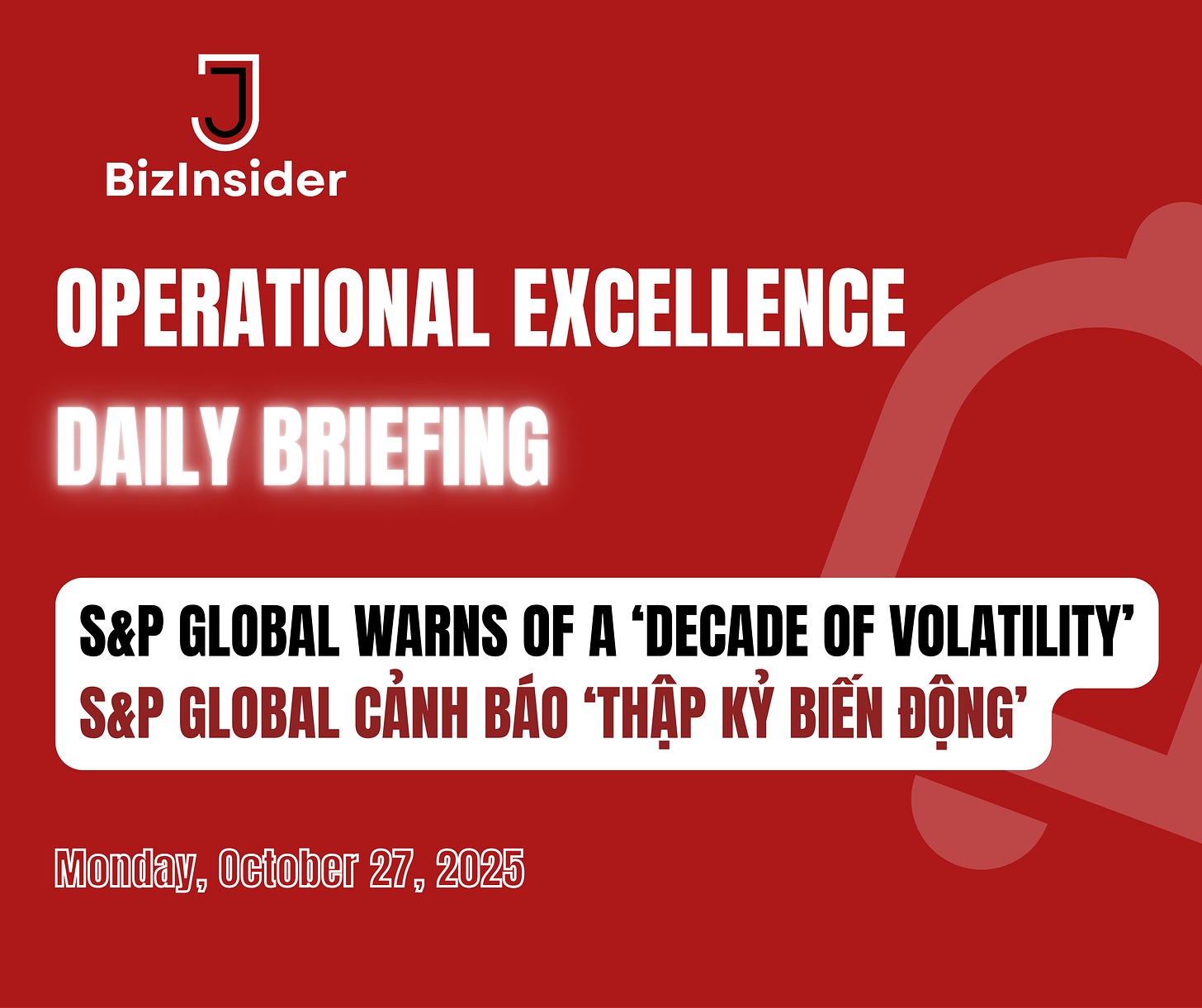Operational Excellence (OPEX) Daily Briefing – Monday, October 27, 2025: S&P Global Warns of a ‘Decade of Volatility’ — Can Operational Excellence Shield Businesses from the Cost Storm?
Điểm Tin Operational Excellence (OPEX) Mỗi Ngày – Thứ Hai, Ngày 27/10/2025: S&P Global Cảnh Báo ‘Thập Kỷ Biến Động’: OPEX Có Cứu Được Doanh Nghiệp Khỏi Sóng Chi Phí?
Welcome to my unique weekday article for the paid subscriber-only edition.
Operational Excellence (OPEX) Daily Briefing – issued on weekdays (Monday to Friday).
Điểm tin Operational Excellence (OPEX) hằng ngày (phát hành các ngày thứ Hai đến thứ Sáu).
This is the bilingual post in English and Vietnamese. Vietnamese is below.
Đây là bài viết song ngữ Anh-Việt. Tiếng Việt ở bên dưới.
English
Part 1: Official Statement – S&P Global Warns of Prolonged Cost Volatility, Businesses Must “Re-engineer Operations”
In recent economic publications and commentary, S&P Global has continuously noted that the pressure of input-costs and supply-chain disruptions remains persistent into 2025, rather than easing as expected. This trend is reinforced by a macroeconomic backdrop fraught with risks: geopolitical conflicts, trade-link disruptions and logistical breakdowns are making manufacturing-to-distribution operations harder to forecast. Global risk surveys from early 2025 also show that fragmentation and uncertainty are rising sharply, laying the foundation for a “new normal” of cost volatility rather than a short-lived shock. (Sources: early-2025 risk analyses and global risk surveys by international organisations.)
For CFOs and operational leaders, the policy signal from the market is clear: instead of focusing solely on localised cost-cuts, organisations must re-engineer their operational systems toward agility and resilience. This involves three pillars:
1. Early-warning identification of risks across the supply chain;
2. Real-time coordination among planning – sourcing – manufacturing – delivery;
3. Data-standardisation to enable fast decision-making, rather than waiting on delayed reports.
Some market signals supporting this “extended volatility” message:
• 2025 global risk surveys list geopolitical and geo-economic fragmentation among the top threats, indicating that trade will continue to suffer high interference, resulting in unpredictable operating costs. (Source: summary of early-2025 global risk surveys.)
• Trade-policy analyses warn that supply-chain restructuring efforts lacking diversification may degrade system efficiency, causing costs and volatility to rise in the medium term. (Source: 2025 trade-policy analysis by international economic organisations.)
Consequences at the operational front-line:
• Demand-planning becomes error-prone if it still relies heavily on historical data;
• Sourcing is exposed to risk when dependent on a single supplier or region;
• Manufacturing lacks capacity flexibility when variability hits fast;
• Logistics face more complex routing, increased lead-times, and declining OTIF (On Time In Full);
• Finance is pressured by unstable input costs and capital costs, forcing the CFO to integrate operational-risk management into the financial plan rather than treat it as an exogenous variable.
Therefore, the governance question is no longer “how to cut costs?” but shifts to “how to design operations that can withstand cost-volatility?”. This mindset requires organisations to shift from static optimisation to dynamic optimisation: rather than fixing a cost-model, businesses need the ability to reconfigure supplier networks, route flexibly, maintain dynamic safety-stocks and implement early-warning metrics tied to risks.
Placed in the larger picture, prolonged cost volatility is not an exceptional short-term event but the new baseline for many industries. CFOs and COOs are thus increasingly expected to move beyond the role of “book-keeper” or “plant-keeper”, and become architects of flexible operational systems: connecting strategy – finance – supply-chain – technology – data into an operational platform capable of foresight, adaptation and recovery in the face of disruption.
In summary, the market message is consistent: costs will remain noisy, risks will remain dense, and those organisations that turn forecast-respond-recover capability into operational habit will gain an advantage. In the next parts, we will delve into context & significance, then the operational-analysis framework, and finally practical lessons to turn this warning into a concrete roadmap for action.



